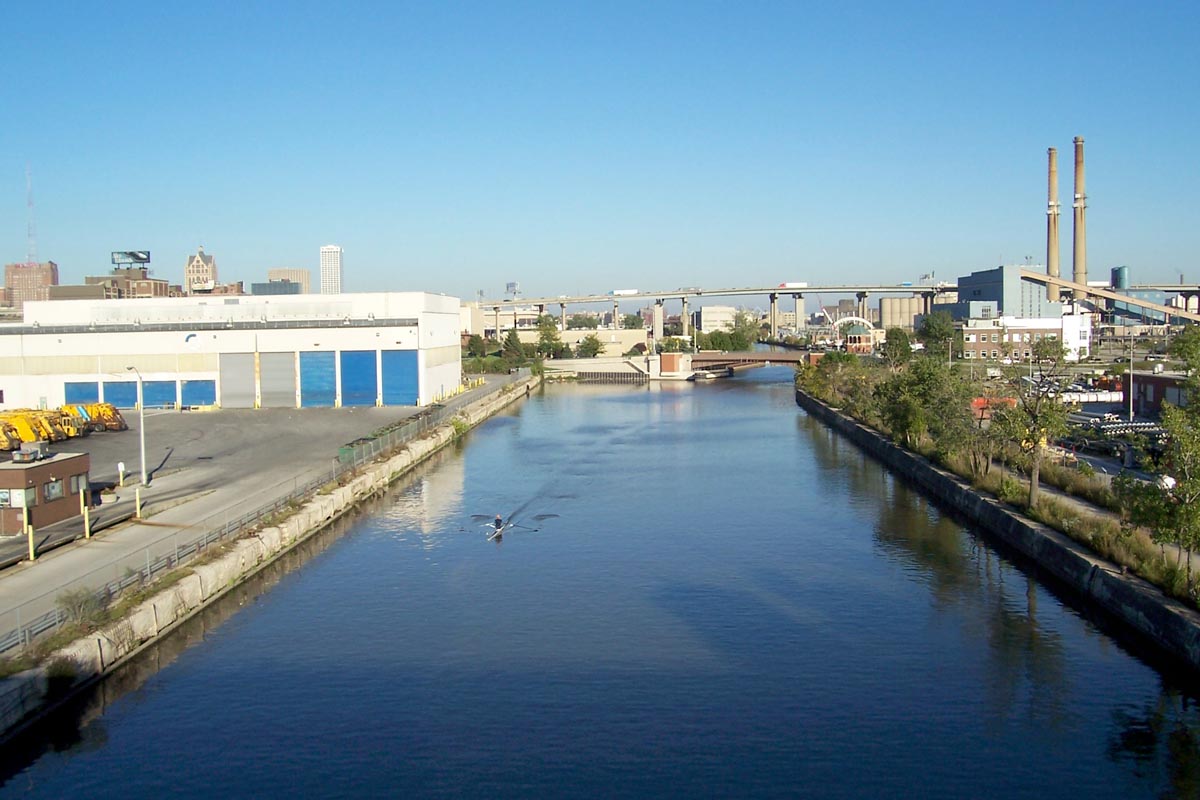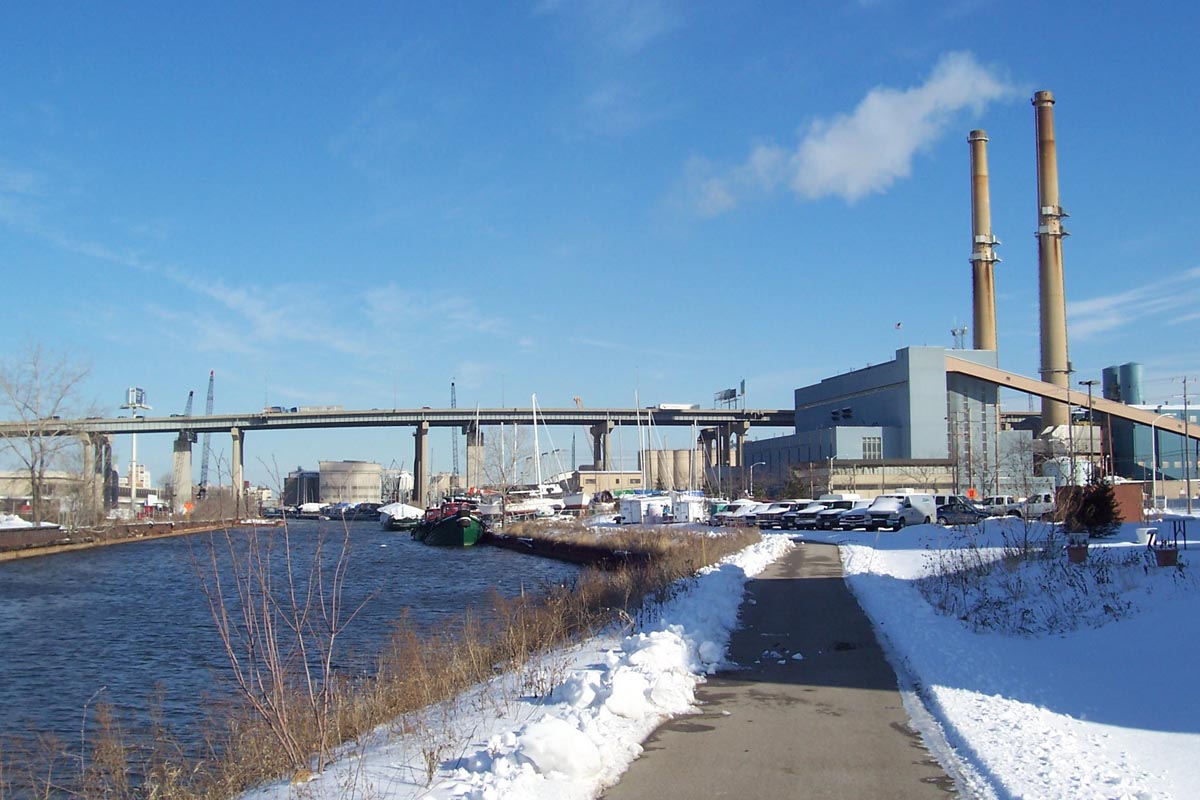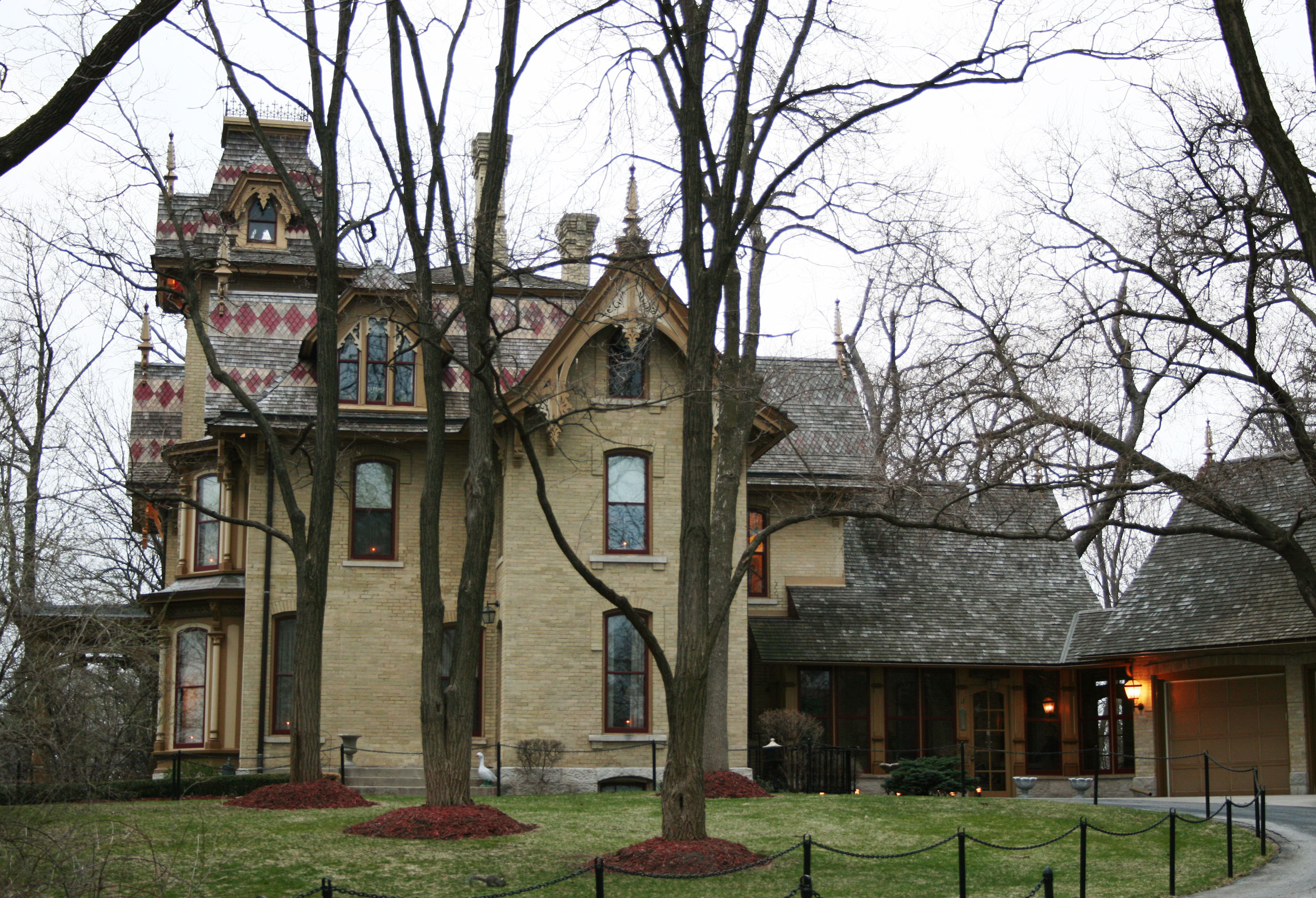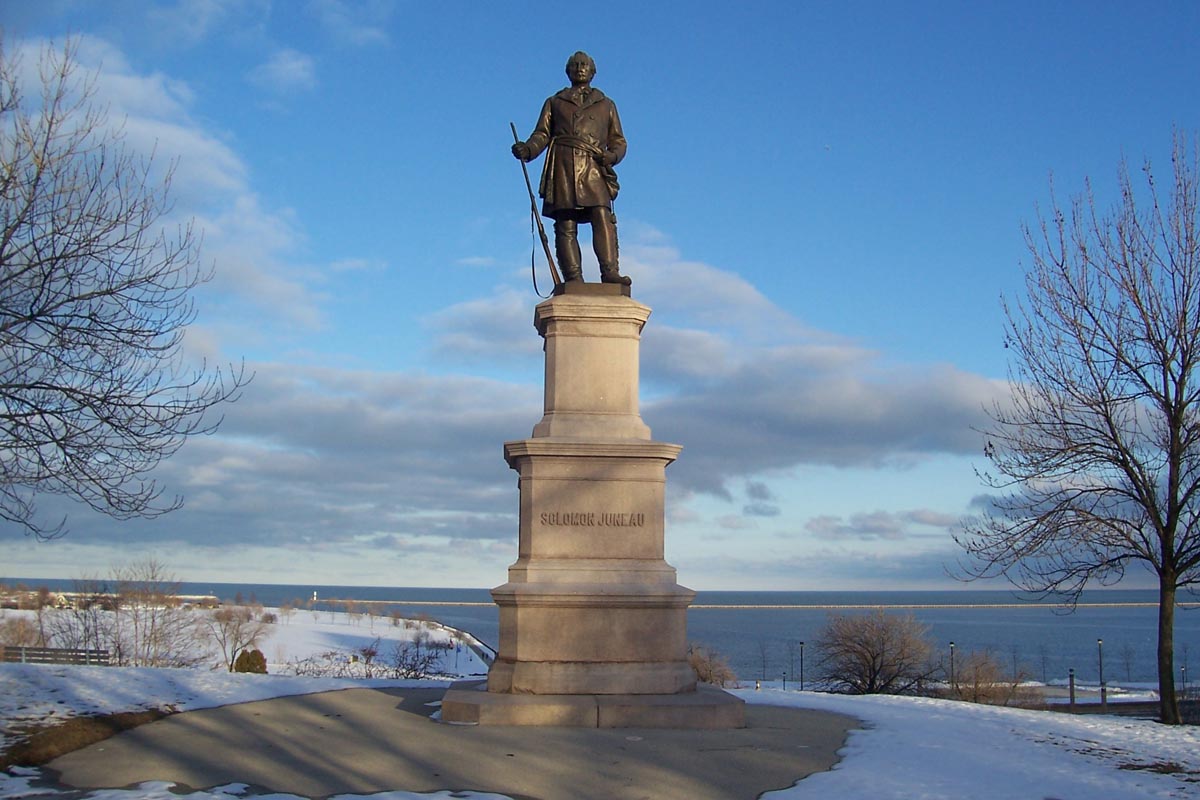|
Menomonee Valley
The Menomonee Valley or Menomonee River Valley is a U-shaped land formation along the southern bend of the Menomonee River in Milwaukee, Wisconsin. Because of its easy access to Lake Michigan and other waterways, the neighborhood has historically been home to the city's stockyards, rendering plants, shipping, and other heavy industry. It was also a primary source of pollution for the river. Glacial meltwater formed the Menomonee Valley over 10,000 years ago when the Lake Michigan Lobe of the Wisconsin Glaciation retreated and eroded a swath four miles (6 km) long and half of a mile wide. Today, it is roughly bounded by the 6th Street Viaduct near the river confluence and Miller Park stadium to the west. The valley effectively cuts Milwaukee in half, limiting access to a handful of viaducts that span the chasm. With a historically predominant white south side and black near north side, the valley has been perceived as a social and racial divide during times of civil unrest. ... [...More Info...] [...Related Items...] OR: [Wikipedia] [Google] [Baidu] |
Menomonee River
:''See also Menominee River'' The Menomonee River is one of three primary rivers in Milwaukee, Wisconsin, along with the Kinnickinnic River and Milwaukee River. Description Named after the Menomonee (also spelled Menominee) Indians, the word was given to the Menomonee people by the Chippewa people, and in the Chippewa language literally means "rice eaters" referring to the abundant wild rice that once grew along its shores in the Menomonee Valley. A tributary of the Milwaukee River, it is the most industrialized within the Milwaukee River Basin. Watershed The Menomonee River is long,U.S. Geological Survey. National Hydrography Dataset high-resolution flowline dataThe National Map, accessed May 19, 2011 and empties into Lake Michigan at Milwaukee. Not to be confused with longer rivers named after the same Indian tribe. With a watershed that covers approximately of urban landscape, it is home to a population of more than 336,670 people. This includes portions of Washington, Oz ... [...More Info...] [...Related Items...] OR: [Wikipedia] [Google] [Baidu] |
French-Canadian
French Canadians (referred to as Canadiens mainly before the twentieth century; french: Canadiens français, ; feminine form: , ), or Franco-Canadians (french: Franco-Canadiens), refers to either an ethnic group who trace their ancestry to French colonists who settled in Canada beginning in the 17th century or to French-speaking or Francophone Canadians of any ethnic origin. During the 17th century, French settlers originating mainly from the west and north of France settled Canada. It is from them that the French Canadian ethnicity was born. During the 17th to 18th centuries, French Canadians expanded across North America and colonized various regions, cities, and towns. As a result people of French Canadian descent can be found across North America. Between 1840 and 1930, many French Canadians immigrated to New England, an event known as the Grande Hémorragie. Etymology French Canadians get their name from ''Canada'', the most developed and densely populated region of ... [...More Info...] [...Related Items...] OR: [Wikipedia] [Google] [Baidu] |
Menomonee Valley
The Menomonee Valley or Menomonee River Valley is a U-shaped land formation along the southern bend of the Menomonee River in Milwaukee, Wisconsin. Because of its easy access to Lake Michigan and other waterways, the neighborhood has historically been home to the city's stockyards, rendering plants, shipping, and other heavy industry. It was also a primary source of pollution for the river. Glacial meltwater formed the Menomonee Valley over 10,000 years ago when the Lake Michigan Lobe of the Wisconsin Glaciation retreated and eroded a swath four miles (6 km) long and half of a mile wide. Today, it is roughly bounded by the 6th Street Viaduct near the river confluence and Miller Park stadium to the west. The valley effectively cuts Milwaukee in half, limiting access to a handful of viaducts that span the chasm. With a historically predominant white south side and black near north side, the valley has been perceived as a social and racial divide during times of civil unrest. ... [...More Info...] [...Related Items...] OR: [Wikipedia] [Google] [Baidu] |
Cream City Brick
Cream City brick is a cream or light yellow-colored brick made from a clay found around Milwaukee, Wisconsin, in the Menomonee River Valley and on the western banks of Lake Michigan. These bricks were one of the most common building materials used in Milwaukee during the mid and late 19th century, giving the city the nickname "Cream City" and the bricks the name "Cream City bricks".Pepper, Terry Characteristics Cream City bricks are made from a red clay containing elevated amounts of lime and sulfur;Paulsen, Eric this clay is common in regions of Wisconsin, especially near Milwaukee. When the bricks are fired, they become creamy-yellow in color. Although light-colored when first made, Cream City bricks are porous, causing them to absorb dirt and other pollutants; this tends to make structures constructed out of them dark-colored as time passes. Once Cream City bricks absorb pollutants, they are difficult to clean, a problem which restoration experts in Milwaukee have been ... [...More Info...] [...Related Items...] OR: [Wikipedia] [Google] [Baidu] |
George Burnham (businessman)
George Burnham (December 28, 1868 – June 28, 1939) was a banker and Republican politician from San Diego, California. He served two terms in the United States House of Representatives from 1933 to 1937. Biography Burnham was born 1868 in London, England, to James and Maria Ann Burnham. He immigrated in 1881 to the United States with his parents, who settled in Spring Valley, Minnesota. He attended public schools in London and Minnesota. Burnham worked as a clerk 1884–1886, then moved to Jackson, Minnesota, in 1887 where he entered the retail shoe business. In 1901 he moved to Spokane, Washington, and worked in real estate and ranching. Burnham moved to San Diego in 1903 and continued to work in real estate with his brother John, until 1917 when he took up banking. Burnham was active in public affairs. Burnham was one of the organizers of the Panama-California Exposition in 1909, serving as vice president from 1909 to 1916. He was also member of the Honorary Commerc ... [...More Info...] [...Related Items...] OR: [Wikipedia] [Google] [Baidu] |
Pfister & Vogel
Pfister & Vogel (P&V) was an American tannery business in Milwaukee, Wisconsin. Frederick Vogel emigrated from Wurtemberg, Germany to Milwaukee. In 1848, he founded a tannery on Milwaukee's Menominee River. Having also emigrated from Wurtemberg in 1845, Vogel's cousin Guido Pfister opened a shoe store on nearby West Water Street. They joined forces as the Pfister & Vogel Leather Company in 1853, and their company thrived, becoming one of the largest leather producers in the country. August H. Vogel was vice-president of the company until his death. The company changed hands several times. Its last owners, U.S. Leather Company, shut it down in 2000. The original Pfister & Vogel campus on Water Street in Downtown Milwaukee was demolished and the site cleaned and prepared for development in 2007. Between 2008 and 2017, Milwaukee based developer Mandel Group constructed a four phase mixed-used development on the grounds. The North End consists of six apartment buildings, a Fres ... [...More Info...] [...Related Items...] OR: [Wikipedia] [Google] [Baidu] |
Tanning (leather)
Tanning is the process of treating Skinning, skins and Hide (skin), hides of animals to produce leather. A tannery is the place where the skins are processed. Tanning hide into leather involves a process which permanently alters the protein structure of skin, making it more durable and less susceptible to decomposition and coloring. Before tanning, the skins are dehaired, degreased, desalted and soaked in water over a period of six hours to two days. Historically this process was considered a noxious or "odoriferous trade" and relegated to the outskirts of town. Historically, tanning used tannin, an acidic chemical compound from which the tanning process draws its name, derived from the bark of certain trees. An alternative method, developed in the 1800s, is chrome tanning, where chromium salts are used instead of natural tannins. History The English word for tanning is from medieval Latin , derivative of (oak bark), from French (tanbark), from old-Cornish (red oak). ... [...More Info...] [...Related Items...] OR: [Wikipedia] [Google] [Baidu] |
German American
German Americans (german: Deutschamerikaner, ) are Americans who have full or partial German ancestry. With an estimated size of approximately 43 million in 2019, German Americans are the largest of the self-reported ancestry groups by the United States Census Bureau in its American Community Survey. German Americans account for about one third of the total population of people of German ancestry in the world. Very few of the German states had colonies in the new world. In the 1670s, the first significant groups of German immigrants arrived in the British colonies, settling primarily in Pennsylvania, New York and Virginia. The Mississippi Company of France moved thousands of Germans from Europe to Louisiana and to the German Coast, Orleans Territory between 1718 and 1750. Immigration ramped up sharply during the 19th century. There is a "German belt" that extends all the way across the United States, from eastern Pennsylvania to the Oregon coast. Pennsylvania, with 3.5 mill ... [...More Info...] [...Related Items...] OR: [Wikipedia] [Google] [Baidu] |
Wheat
Wheat is a grass widely cultivated for its seed, a cereal grain that is a worldwide staple food. The many species of wheat together make up the genus ''Triticum'' ; the most widely grown is common wheat (''T. aestivum''). The archaeological record suggests that wheat was first cultivated in the regions of the Fertile Crescent around 9600 BCE. Botanically, the wheat kernel is a type of fruit called a caryopsis. Wheat is grown on more land area than any other food crop (, 2014). World trade in wheat is greater than for all other crops combined. In 2020, world production of wheat was , making it the second most-produced cereal after maize. Since 1960, world production of wheat and other grain crops has tripled and is expected to grow further through the middle of the 21st century. Global demand for wheat is increasing due to the unique viscoelastic and adhesive properties of gluten proteins, which facilitate the production of processed foods, whose consumption is inc ... [...More Info...] [...Related Items...] OR: [Wikipedia] [Google] [Baidu] |
Byron Kilbourn
Byron Kilbourn (September 8, 1801December 16, 1870) was an American surveyor, railroad executive, and politician who was an important figure in the founding of Milwaukee, Wisconsin. He was the 3rd and 8th mayor of Milwaukee. Biography Kilbourn was born in Granby, Connecticut. In 1803, he moved with his family to Worthington, Ohio, which his father had helped found that year. Kilbourn's father was James Kilbourne, a colonel during the War of 1812 and a U.S. Representative from Ohio from 1813 to 1817. Byron Kilbourn worked in Ohio as a surveyor and as a state engineer. He first visited Wisconsin in 1834, landing at Green Bay, and worked as a government surveyor in the area. He later deemed the area near the Milwaukee River to be a promising location for commerce, and he purchased land there. In 1837 Kilbourn founded Kilbourntown (present-day Westown), which rivaled with Solomon Juneau's Juneautown (present-day East Town) and George Walker's Walker's Point. He was a key figur ... [...More Info...] [...Related Items...] OR: [Wikipedia] [Google] [Baidu] |
The Menomonee Valley In Milwaukee 1882
''The'' () is a grammatical article in English, denoting persons or things that are already or about to be mentioned, under discussion, implied or otherwise presumed familiar to listeners, readers, or speakers. It is the definite article in English. ''The'' is the most frequently used word in the English language; studies and analyses of texts have found it to account for seven percent of all printed English-language words. It is derived from gendered articles in Old English which combined in Middle English and now has a single form used with nouns of any gender. The word can be used with both singular and plural nouns, and with a noun that starts with any letter. This is different from many other languages, which have different forms of the definite article for different genders or numbers. Pronunciation In most dialects, "the" is pronounced as (with the voiced dental fricative followed by a schwa) when followed by a consonant sound, and as (homophone of the archaic pron ... [...More Info...] [...Related Items...] OR: [Wikipedia] [Google] [Baidu] |
Solomon Juneau
Solomon Laurent Juneau, or Laurent-Salomon Juneau (August 9, 1793 – November 14, 1856) was a French Canadian fur trader, land speculator, and politician who helped found the city of Milwaukee, Wisconsin. He was born in Repentigny, Quebec, Canada to François and (Marie-)Thérèse Galarneau Juneau. His cousin was Joseph Juneau, who founded the city of Juneau, Alaska. Biography After landing at Fort Michilimackinac in 1816, Juneau worked as a clerk in the fur trade before becoming an agent for the American Fur Company in Milwaukee. He had been summoned to the Milwaukee area by Jacques Vieau, a French-Canadian fur trader and the first permanent white settler in Milwaukee, Wisconsin. In 1818 Jacques Vieau hired Solomon Juneau, based on the accounting prowess Juneau had become known for, and Juneau's reputation for being able to deal well with the local native Americans. Juneau later married one of Vieau's daughters, Josette, and went on to found what was to become the City of Milwa ... [...More Info...] [...Related Items...] OR: [Wikipedia] [Google] [Baidu] |








.png)
